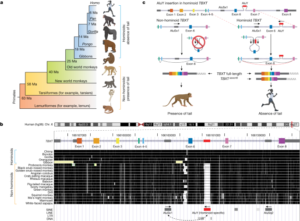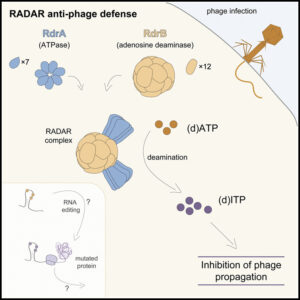ageing-related inflammation and neurodegeneration을 촉진하는
cGAS-STING.
Abstract
Low-grade inflammation은 old age의 hallmark이며
ageing-associated impairment and disease의 핵심 원인입니다.
ageing-associated inflammation에는 여러 가지 요인이 관여할 수 있지만,
aberrant inflammatory signalling을 전달하는 molecular
pathways와 natural ageing에 미치는 영향은 아직 명확하지 않습니다.
본 연구에서는 DNA의 immune
sensing을 매개하는 cGAS-STING signalling pathway가 ageing 중 chronic inflammation and
functional decline의 critical driver라는 것을 보여주었습니다. STING을 차단하면 senescent human cells and
tissues의 inflammatory phenotypes이 억제되고, mice의 multiple peripheral organs and the
brain에서 ageing brain이 약화되며,
tissue function이 개선되는 것으로 나타났습니다. ageing brain에 초점을
맞춰 STING의 activation이 reactive microglial transcriptional states, neurodegeneration and
cognitive decline을 유발한다는 사실을 밝혀냈습니다. perturbed
mitochondria에서 방출된 Cytosolic DNA는 old microglia에서 cGAS activity를 유발하여 ageing brain에서 cGAS-STING signalling이
관여하는 메커니즘을 정의합니다. cGAS gain-of-function mouse model의 microglia and hippocampi에 대한 Single-nucleus
RNA-sequencing analysis는 microglia에서 cGAS의 engagement가
bystander cell inflammation, neurotoxicity and impaired memory capacity로
이어지는 ageing-associated transcriptional microglial states를
지시하기에 충분하다는 것을 보여줍니다.
우리의 연구 결과는 peripheral organs and the brain에서 ageing-related inflammation을 유발하는 요인으로
cGAS-STING pathway를 확립하고 노년기의 neurodegenerative
processes를 막기위한 잠재적인 전략으로 cGAS-STING signalling의
차단을 밝힙니다.
Figure
STING elicits age-related inflammation
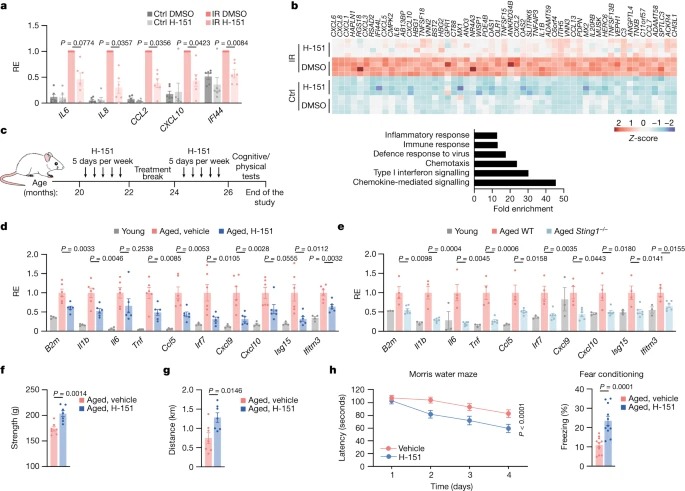
Fig. 1: STING은 aged mice의 low-grade inflammation and functional decline을 촉진합니다.
(A,B) human WI-38 fibroblasts에 irradiated (12Gy, IR) or 5% O2로 유지(Ctrl)군의 senescent (day 10 to 20)시 10일간 H-151(daily, 0.5μM) 또는 DMSO로 처리한 후, proinflammatory genes 및 ISG의 mRNA expression levels (a) 및 RNA-seq analysis (b).
(B) irradiation 후 most upregulated되고, H-151 처리 후 suppressed된 The top 50 genes (상단) 및 위 list of genes을 기반으로 한 fold enrichment를 보여주는 gene set enrichment analysis (하단).
▷ H-151-mediated STING inhibition은 senescence의 다양한 맥락에서 senescent cells의 다른 non-inflammatory features에 영향을 미치지 않고 여러 proinflammatory genes and type I interferon (IFN)-stimulated genes (ISGs)의 induction을 효율적으로 suppressed.
▶ 이러한 데이터는 in cells and in human tissue 모두에서 STING을 inhibition하면 ageing 중 inflammation의 major contributors인 senescent cells의 inflammatory response를 block할 수 있음을 입증.
(C) d 및 f-h에 표시된 데이터와 관련된 wild-type (WT) aged mice를 H-151로 처리하는 개략도.
▷ H-151을 사용하여 노령 마우스에서 STING을 차단.
(D) young 및 H-151을 treated with or without한 aged mice에 대한 proinflammatory genes and ISGs의 Kidney mRNA expression levels.
▷ very old age (26개월)에 mice는 kidneys and the liver에서 inflammatory and type I IFN signature를 보임.
▷ 특히 various ageing-related immune signature genes이 STING inhibition의 결과로 현저히 attenuated.
(E) young 및 aged WT 및 Sting1-/- mice에 대한 proinflammatory genes and ISGs의 Kidney mRNA expression levels.
▷ old wild-type mice에 비해 aged Sting1-/- mice는 ageing-related immune markers의 levels이 감소하여 in vivo에서 mice의 STING 역할을 연구하는 데 있어 H-151의 효과를 independently하게 검증.
다음으로 STING-dependent inflammation의 약화가 old mice의 physical and cognitive function에 영향을 미치는지 여부를 조사.
(F,G) grip strength (f)와 treadmill running distance (g)로 평가한 H-151 treated with or without한 aged mice의 physical condition.
▷ grip strength and treadmill로 측정한 muscle strength and physical endurance는 각각 control mice에 비해 H-151-treated aged mice에서 개선.
(h) Morris water maze test (왼쪽, 플랫폼에 도달하는 데 걸리는 시간/ multiple days)와 fear conditioning (오른쪽, freezing한 시간 비율)을 사용하여 평가한 Cognitive function tests.
▷ hippocampal-dependent learning and memory performance를 테스트한 결과, STING을 inhibition하면 Morris water maze test에서 spatial memory이, contextual-fear-conditioning test에서 associative memory가 크게 향상되는 것을 관찰.
cGAS–STING affects brain ageing
ageing brain에서 maladaptive inflammatory and type I IFN responses의 initiation의 기초가 되는 signalling mechanisms은 불완전하게 이해되고 있습니다. 따라서 우리는 brain ageing에 대한 cGAS-STING pathway의 기여를 이해하는 데 중점을 두었습니다.
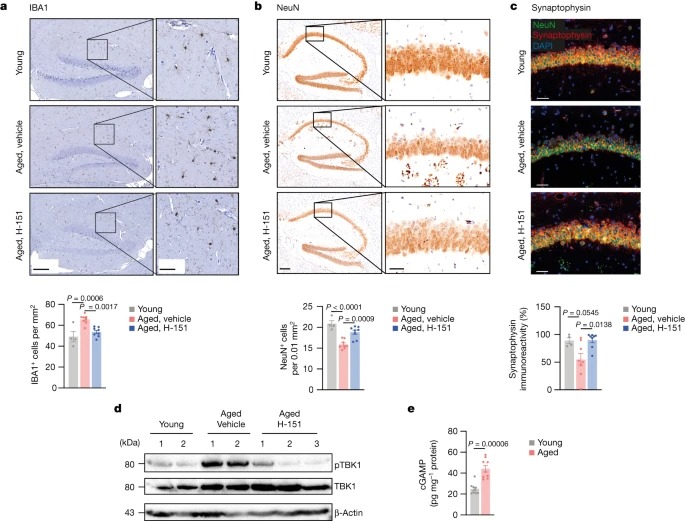
Fig. 2: cGAS-STING activity는 aged brain의 degenerative processes를 촉진합니다.
(A-C) H-151을 treated with or without한 young 및 aged mice의 brain sections에서 CA1 region의 hippocampal IBA1+ cells (a), NeuN+ cells (b) 및 synaptophysin intensity (c)의 Representative images and quantification.
▷ hippocampal parenchyma의 Histopathological examination에서 aged mice에서 microgliosis가 발견되었으며, 이는 STING inhibition시 감소 (Fig. 2a).
▷ STING inhibition은 hippocampus의 CA1 region에서 neurons의 loss로부터 mice를 보호하고 synaptic activity의 marker인 synaptophysin의 local levels을 증가시킴 (Fig. 2b,c).
▶ 따라서 이러한 결과는 STING이 aged mice의 brain homeostasis에 영향을 미친다는 것을 의미.
ageing에서 systemic factors는 adult neurogenesis를 손상시키고 cognitive dysfunction을 유발할 수 있습니다. 관찰된 효과가 brain-intrinsic STING activity에서 비롯된 것인지 확인하기 위해 aged mice의 whole-brain lysates에서 STING signalling의 biomarkers를 분석했습니다.
(D) young mice, aged mice 및 H-151로 acutely treated한 aged mice (5 daily for 5 consecutive days)의 brain lysates에서 pTBK1의 Western blot analysis.
▷ STING의 downstream에서 signal transduction을 담당하는 major kinase인 phosphorylated TBK1(Ser172; pTBK1)의 levels이 aged mouse brains에서 증가.
▷ aged mice에서 Acute STING inhibition을 시행한 결과 pTBK1 signal이 감소했으며, 이는 STING-TBK1 signalling axis가 aged brain에 locally하게 관여하고 있음을 나타냄
(E) young and aged mice의 brain lysates에서 nzyme-linked immunosorbent assay (ELISA)로 측정한 cGAMP production.
▷ DNA sensing에서 STING은 cGAS에 의해 endogenously하게 생성되는 2′3′-cGAMP (cGAMP)에 의해 activated됨. 우리는 old mice의 brain lysates에서 robust cGAMP production을 감지했지만 young mice는 감지하지 못했음.
STING activity in aged microglia
brain에서 cGAS–STING activation의 기저에 있는 잠재적 메커니즘을 밝히기 위해, 우리는 H-151을 treated with or without한 young adult mice and old mice의 hippocampi에 대한 bulk RNA-sequencing (RNA-seq) analysis를 수행했습니다.
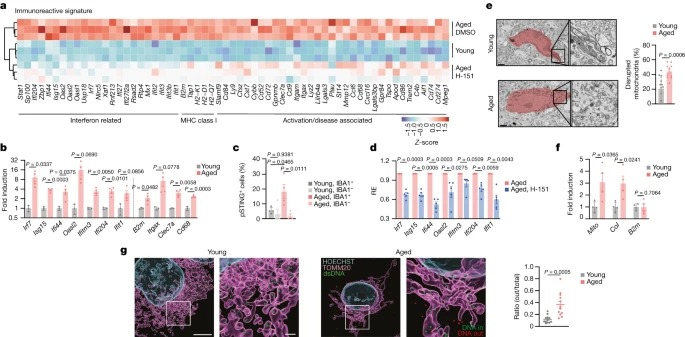
Fig. 3: aged mice의 microglia에서 Aberrant cGAS–STING activation에는 mtDNA가 관여합니다.
(A) H-151을 treated with or without한 young and aged mice의 bulk hippocampus RNA-seq analysis를 통한 Differential gene expression.
▷ Transcriptional analysis 결과, young and old hippocampi 사이에 459개의 differentially expressed genes (DEG)이 발견되었으며, 이들 genes 중 상당수는 type I IFN signalling and microglial function과 관련된 genes을 포함하여 innate immunity에 관여하는 것으로 나타남.
▷ H-151을 투여한 그룹에서는 several DEG의 Induction이 약화되었으며, 이는 young mice와 함께 clustered됨.
(B) young and aged mice에서 분리한 primary microglia에서 immunoreactive genes, ISG 및 activation markers의 mRNA expression levels.
▷ CNS의 immune state를 형성하는 중심적인 역할에 걸맞게, old mice의 brain에서 분리된 primary microglia는 innate immune genes의 expression이 유사하게 증가.
▷ 따라서 우리는 brain ageing에서 STING의 neurodegenerative effects가 microglia와 관련이 있다고 생각.
Microglia 내 STING response를 조사하기 위해 hippocampal area에서 STING activity의 direct marker인 phosphorylated STING (Ser365; pSTING)을 시각화
(C) young and aged hippocampal sections에서 IBA1- 및 IBA1+ cells에 대한 pSTING staining의 Confocal imaging quantification.
▷ young mice에 비해 aged hippocampi에서는 pSTING foci가 enriched했으며, 대부분의 pSTING signal은 IBA1+ microglia에서 유래함.
(D) H-151로 treated with or without한 aged mice의 microglia에서 immunoreactive genes and ISGs의 mRNA expression levels.
▷ aged microglia를 사용한 Ex vivo experiments에서 type I IFN and proinflammatory genes의 STING-dependent expression 확인.
▶ 종합적으로, 이러한 결과는 ageing brain에서 innate immune activation을 지시하는 old mice의 microglia에서 STING activity를 보여줌.
mtDNA activates cGAS in aged microglia
Mitochondrial DNA(mtDNA)는 cGAS-STING signalling의 central activator이며, disrupted mitochondrial homeostasis는 ageing and neurodegenerative disease의 hallmark임.
(E) 각 조건당 3마리의 마우스에서 무작위로 선택된 young and aged cells에서 age-related microglial morphological differences와 disrupted mitochondria per hippocampal microglia의 percentage를 나타내는 Transmission electron microscopy images.
▷ transmission electron microscopy로 관찰한 결과, aged microglia의 mitochondria는 기형적으로 보였고 characteristic internal structure가 결여되어있음.
(F) young and aged mice에서 분리한 microglia에서 Mito (mitochondrial DNA sequence), CoI and B2m의 Cytosolic expression levels.
▷ young mice의 microglia와 비교했을 때, aged microglia는 mtDNA가 증가했지만 genomic DNA species는 증가하지 않은 것으로 나타남.
(G) young and aged mice에서 분리한 microglia에서 mitochondria 외부의 cytosolic DNA foci의 Airyscan images 및 quantification에서 Representative 3D reconstructions.
▷ aged microglia의 Super-resolution Airyscan imaging은 young microglia의 cytosol에는 거의 존재하지 않는 mitochondria outer membrane에 인접한 mtDNA nucleoids의 prominent cytosolic accumulation을 확인.
▶ 이러한 데이터는 aged microglia에서 inflammatory responses를 유도하는 데 있어 mtDNA의 역할을 나타내며 ageing and senescence 중 cGAS-STING activation에 대한 molecular model을 정의.
Effect of microglial cGAS on the brain
neurodegenerative conditions에는 age-related neurodegeneration을 촉진하는 cGAS–STING signalling axis와 시너지 효과를 낼 수 있는 distinct immune signalling mechanisms이 연관되어 있다. 우리는 neuropathological features를 유발하기에 cGAS-STING pathway의 관여만으로 충분한지 확인했다.
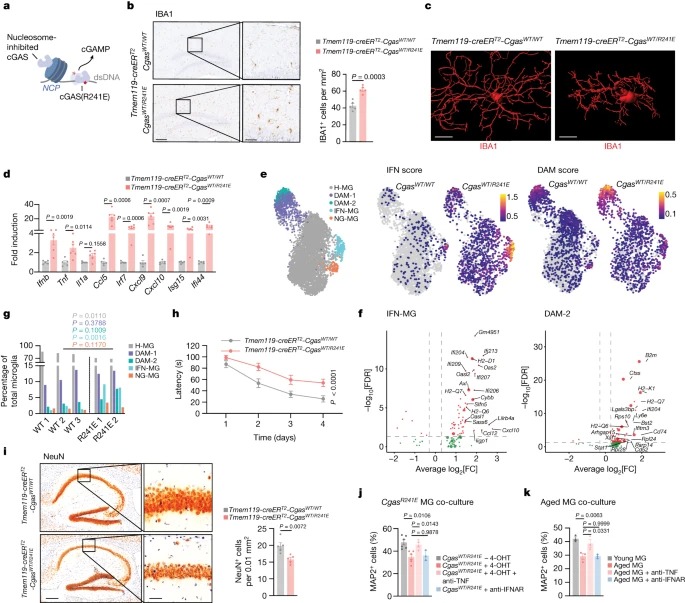
Fig. 4: cGAS의 Selective engagement는 age-associated microglial states 및 neurodegeneration의 특징을 촉진합니다.
(A) nucleosome-binding-defective cGAS-mutant activation의 개략도.
▷ 이전연구에서 cGAS는 nucleosome에 결합하여 suppressed되고 nucleosome regulation을 disruption하면 cGAS의 robust DNA-dependent activation이 가능하다는 것을 보여줌.
(B) Tmem119-creERT2-CgasWT/WT 및 Tmem119-creERT2-CgasWT/R241E mice의 hippocampal IBA1 staining의 Representative images and quantification.
(C) IMARIS로 재구성한 Representative IBA1+ microglia.
▷ Tamoxifen administration 후 2주 후, mg-CgasR241E mice는 control mice에 비해 hippocampus를 포함한 several brain region에서 activated morphology를 가진 microglia의 수가 크게 증가 (Fig. 4b,c).
(D) Tmem119-creERT2-CgasWT/WT 및 Tmem119-creERT2-CgasWT/R241E mice의 proinflammatory genes 및 ISG의 Brain mRNA expression levels.
▷ tamoxifen-treated mg-CgasR241E mice의 brains에서 inflammatory genes and type I IFN-related genes의 levels이 상승
(E) cell identity (homeostatic microglia (H-MG), disease-associated microglia (DAM-1/2), IFN-associated microglia (IFN-MG), neurodegenerative-associated microglia (ND-MG))에 따라 색이 지정된 microglial single nuclei를 시각화한 Uniform manifold approximation and projection (UMAP) plots (왼쪽) 및 Cgas genotype별로 나눈 IFN/DAM gene expression scores (오른쪽).
▷ Clustering analysis 결과, homeostatic microglial population에서 분리된 unique transcriptional profile을 나타내는 microglia의 three distinctive transcriptional states가 밝혀짐.
▷ 세 가지 상태의 세포 각각은 IFN signature (Ifits, Oasl1, Oasl2, Isg15, Stat2), the DAM-signature (B2m, Ctsb, Ctsd, Ctsz, Cd9, Cd63) and the neurodegenerative signature (Apbb2, Olfr111, Xylt1) 관련 genes을 strongly upregulated.
(F) IFN-MG 및 DAM-2-MG에서 CgasWT/WT와 CgasWT/R241E 사이의 DEG.
(G) Tmem119-creERT2-CgasWT/WT 및 Tmem119-creERT2-CgasWT/R241E microglia의 snRNA-seq 분석에서 확인된 microglia populations의 relative proportions.
▷ DAM subtype 내에서 lower to more highly activated state (DAM-1에서 DAM-2로)로의 progression이 관찰되었으며, more activated state에서 더 많은 비율의 mg-CgasR241E cells이 존재하는 것으로 나타남(Fig. 4e,g).
▷ two mouse model을 비교한 결과, mg-CgasR241E cells에서 IFN 및 DAM states (특히 DAM-2 population 내에서)와 관련된 genes의 expansion and higher expression이 모두 확인되었으며, global microglial population에서 IFN signature가 전반적으로 증가(Fig. 4e,g).
▶ 따라서 이러한 데이터는 additional trigger가 없는 경우, cGAS만으로도 microglia가 ageing- and disease-related activation states로의 전환을 촉진하기에 충분하다는 것을 입증.
▶ microglia의 cell-intrinsic effects 외에도 cGAS activation은 aged brains에서 발생하는 것과 유사한 non-immune glial cells의 transcriptional programmes을 directs.
cGAS activation drives neurodegeneration
microglia의 cGAS activity가 neurodegenerative processes를 시작할 수 있는지 확인하기 위해 hippocampal-dependent learning과 hippocampal neuron density를 brain plasticity에 대한 두 가지 독립적인 척도로 조사함.
(H) Tmem119-creERT2-CgasWT/WT 및 Tmem119-creERT2-CgasWT/R241E mice의 Morris water maze test.
(I) Tmem119-creERT2-CgasWT/WT 및 Tmem119-creERT2-CgasWT/R241E mice의 hippocampal CA1 region에 있는 NeuN+ cells의 Representative images and quantification.
▷ control group과 비교했을 때, mg-CgasR241E mice는 Morris water maze test에서 cognitive performance가 저하되고 hippocampal neuron density가 수반되는 loss를 보임(Fig. 4h,i).
(J) treated with or without 4-OHT and with TNF-neutralizing 또는 IFNAR-neutralizing antibodies로 처리한 Rosa26-creERT2-CgasWT/R241E-isolated microglia와 배양한 MAP2+ neurons의 relative survival.
▷ cGAS activity는 neuronal cell survival을 potently suppressed했으며, 이 효과는 CgasR241E-expressing cells의 conditioned medium을 사용하여도 재현되었으며, 이는 cGAS-mediated neurotoxicity가 soluble mediators의 secretion을 포함한다는 것을 나타냄.
▷ TNF에 대한 neutralizing antibodies를 추가하면 CgasR241E에 의해 유도된 neuronal death가 strong rescue.
▷ 대조적으로 type I IFN signalling 차단은 효과 없음.
(K) TNF- or IFNAR-neutralizing antibodies를 투여한 young and aged mice의 microglia로 처리한 Rosa26-creERT2-CgasWT/R241E-isolated microglia와 배양한 MAP2+ neurons의 relative survival.
▷ aged microglia와의 Co-culture experiment를 통해 aberrant cGAS activity와 compromised neuronal cell survival를 연결하는 데 TNF가 중요한 역할을 하는 것을 확인.
Disscussion
여기서 우리는 ageing-related inflammation의 중요한 driver로서 cGAS-STING pathway를 확립하고 ageing-associated neurodegeneration의 확립에 대한 microglial intrinsic engagement of cGAS–STING를 정의합니다. brain cells, 특히 microglia에서 type I IFN signature의 존재는 다양한 종에서 ageing and neurodegenerative disease와 점점 더 연관성이 높아지고 있습니다. naturally aged mice를 대상으로 한 우리의 연구는 cGAS-STING signalling의 activation이 neuronal loss and cognitive impairment를 직접적으로 유발하는 microglia에서 ageing-related type I IFN response에 필수적인 기여를 한다는 것을 보여줍니다. Single-cell transcriptional profiling에 따르면 gain-of-function mice의 경우, type I IFNs 외에도 cGAS activation만으로도 많은 neurodegenerative disease states와 ageing 과정에서 공유되는 core microglial gene expression program을 유발하는 것으로 밝혀졌습니다. 따라서 이러한 결과는 natural ageing과는 별개로 degenerative brain disorders에서 microglial cGAS–STING activation이 보다 광범위한 역할을 한다는 것을 시사합니다.
In vitro co-culture studies에 따르면 TNF는 cGAS-controlled microglial response의 critical neurotoxic factor임이 밝혀졌습니다. 또한, snRNA-seq analyses를 통해 neurotoxic signals을 전파하는 데 중요한 intermediary cells로 기능할 수 있는 oligodendrocytes and astrocytes의 활성화 상태에 상당한 secondary changes가 있음을 발견했습니다. cGAS의 downstream에서 microglial-dependent neurotoxicity를 결정하는 정확한 neuroimmune crosstalk을 규명하는 것은 neurodegeneration에서 microglia의 역할에 대한 통찰력을 제공할 것이며 향후 연구에 중요한 영역입니다.
활성화된 microglia의 mechanistic characterization에 따르면 mtDNA가 cytoplasm에 축적되어 aged cells을 자극함으로써 ageing의 두 가지 central features, 즉 mitochondrial dysfunction and inflammation 사이의 functional link를 제공한다는 사실이 밝혀졌습니다. 이전 연구에서는 DNA damage products 및 retroelement amplification이 senescence에서 cGAS의 upstream triggers로 밝혀졌습니다. 우리는 다른 복잡한 질병과 마찬가지로 ageing에서도 서로 다른 DNA sources가 시너지 효과를 발휘하여 cGAS activity를 촉진할 수 있다는 가설을 세웠습니다. 우리는 aberrant mtDNA가 peripheral ageing-related inflammatory phenomena에도 기여하며, 이는 cGAS-STING cascade에 의해 제어된다고 제안합니다.
neurodegeneration에 수반되는 inflammatory response의 damage-associated triggers는 disease-specific manner로 생성될 수 있습니다. Alzheimer’s disease, Parkinson’s disease, amyotrophic lateral sclerosis and frontotemporal dementia, and Nieman–Pick’s disease 모델에 대한 이전 연구와 함께 본 연구는 chronic neurodegenerative conditions에서 cGAS-STING signalling에 대한 주목할 만한 수렴을 보여줍니다. 자세히 살펴보면 immune activation의 molecular (genomic versus mtDNA) 및 cellular (microglia versus neurons) origin과 관련하여 차이가 나타나며, 이는 아마도 질병 자체의 characteristics에도 영향을 미칠 것입니다.

